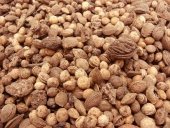


 described a fish sauce being made from an open-air mesh bag of fish with the drippings being collected underneath, rather than a fermentation vessel. I haven't seen anything to corroborate this account though. I've got to pick up the fish the next time I visit the ethnic grocery... I'll post an update, but will be using info from Christianne Muuser's page: http://www.coquinaria.nl/english/recipes/garum.htm
described a fish sauce being made from an open-air mesh bag of fish with the drippings being collected underneath, rather than a fermentation vessel. I haven't seen anything to corroborate this account though. I've got to pick up the fish the next time I visit the ethnic grocery... I'll post an update, but will be using info from Christianne Muuser's page: http://www.coquinaria.nl/english/recipes/garum.htm

 , but didn't seem to spur the mushrooms into pinning out. Trichoderma remains in bloom, especially on the ends of the logs. Things look like spring here, with only a couple more nights of 0 degree weather. My other option is to let the logs in contact with the ground, to maintain moisture.
, but didn't seem to spur the mushrooms into pinning out. Trichoderma remains in bloom, especially on the ends of the logs. Things look like spring here, with only a couple more nights of 0 degree weather. My other option is to let the logs in contact with the ground, to maintain moisture.







drake schutt wrote:...
Who even knows if plants uptake BPA? Or if it's bio-magnified up the food chain?
Abstract
Many pharmaceutical and personal care products (PPCPs) and endocrine-disrupting chemicals (EDCs) are present in reclaimed water, leading to concerns of human health risks from the consumption of food crops irrigated with reclaimed water. This study evaluated the potential for plant uptake and accumulation of four commonly occurring PPCP/EDCs, i.e., bisphenol A (BPA), diclofenac sodium (DCL), naproxen (NPX), and 4-nonylphenol (NP), by lettuce (Lactuca sativa) and collards (Brassica oleracea) in hydroponic culture, using (14)C-labeled compounds. In both plant species, plant accumulation followed the order of BPA > NP > DCL > NPX and accumulation in roots was much greater than in leaves and stems. Concentrations of (14)C-PPCP/EDCs in plant tissues ranged from 0.22 ± 0.03 to 927 ± 213 ng/g, but nearly all (14)C-residue was non-extractable. PPCP/EDCs, particularly BPA and NP, were also extensively transformed in the nutrient solution. Dietary uptake of these PPCP/EDCs by humans was predicted to be negligible.
John Chater · University of California, Riverside ...
BPA is a relatively large (and nonpolar) molecule compared to the ions that plants typically take up (K+, N03-, Mg++, ect.), so I do not think that the plant will take up the BPA (which has two phenol groups in the structure), so there is theoretically no way for the soil's BPA to get into the crop. Which crops are you interested in?
Remember, all materials need to pass through the Casparian strip in order to make through the root's endodermis and into the vasculature. [emphasis mine]